NVIDIA Tegra X1 Preview & Architecture Analysis
by Joshua Ho & Ryan Smith on January 5, 2015 1:00 AM EST- Posted in
- SoCs
- Arm
- Project Denver
- Mobile
- 20nm
- GPUs
- Tablets
- NVIDIA
- Cortex A57
- Tegra X1
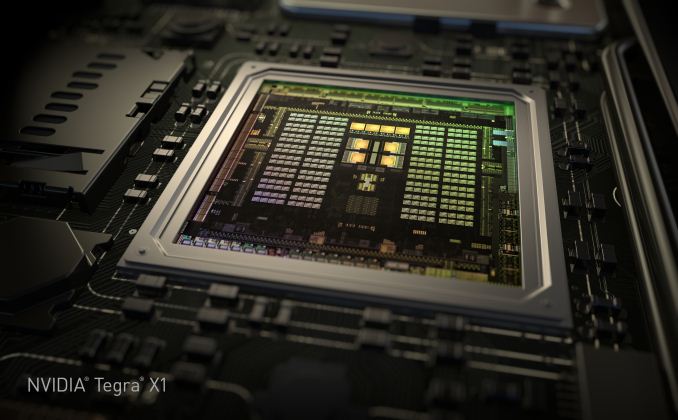
In the past few years, we’ve seen NVIDIA shift their mobile strategy dramatically with time. With Tegra 2 and 3, we saw multiple design wins in the smartphone space, along with the tablet space. These SoCs often had dedicated GPUs that were quite unlike what we saw in NVIDIA’s desktop and laptop GPUs, with a reduced feature set and unique architecture. However, with Tegra K1 we saw a distinct shift in NVIDIA’s SoC strategy, as the Tegra K1 was the first mobile SoC to achieve parity in GPU architecture with desktop GPUs. In the case of the Tegra K1, this meant a single Kepler SMX which made for truly incredible GPU performance. However, in the time since we’ve seen companies like Apple release new SoCs such as the A8X, which managed to bring largely similar performance with less power.
NVIDIA of course is never content to stay idle for too long and let themselves be surpassed, which has led to the company developing their Tegra SoCs on a roughly yearly cadence. In NVIDIA’s development timeline, 2014 brought us the Tegra K1-32, the company’s first SoC to integrate a modern high-performance GPU architecture (Kepler), and later on the TK1-64, a K1 with NVIDIA’s own in-house developed ARMv8 Denver CPU in place of the 32bit ARM A15 CPU.
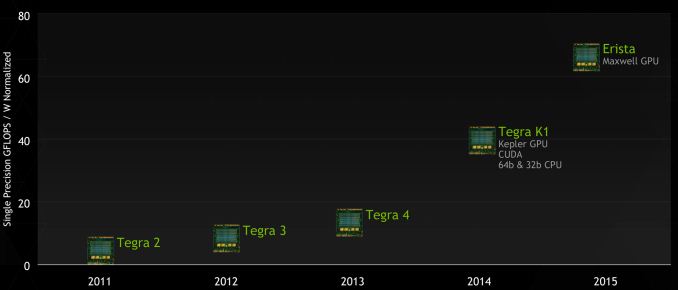
NVIDIA's GTC 2014 Tegra Roadmap
2014 also brought a revision to NVIDIA’s public Tegra roadmap: for 2015 NVIDIA would bump the previously announced Parker SoC and release a new in its place, Erista. This schedule change ended up being quite a surprise due to the fact that NVIDIA had up until this time released their roadmaps roughly 2 years out, whereas Erista was put on the map less than a year before it was to be announced. More unusual, NVIDIA offered up minimal details of Erista; it would be powered by a Maxwell GPU with no additional information on the CPU or manufacturing process. Parker on the other hand – NVIDIA’s planned Denver + Maxwell + 16nm FinFet part – fell off the schedule, with NVIDIA not officially canceling it but also saying little else about it.
Now in 2015 and with the launch of the Tegra X1, we can finally begin putting the picture together. Erista as it turns out is something of a rapid release product for NVIDIA; what had been plans to produce a 16nm FF part in 2015 became plans to produce a 20nm part, with Erista to be that part. To pull together Erista NVIDIA would go for a quick time-to-market approach in SoC design, pairing up a Maxwell GPU with ARM Cortex A57 & A53 GPUs, to be produced on TSMC’s 20nm SoC process.
CPU
We’ll kick off our look at Erista then with a look at Erista’s CPUs, where one of the bigger surprises in Erista is the CPU configuration. While Tegra K1 had a version with NVIDIA’s custom Denver core for the CPU, NVIDIA has elected to use ARM’s Cortex A57 and A53 in the Tegra X1. The A57 CPU cluster has 2MB of L2 cache shared across the four cores, with 48KB/32KB L1s (I$+D$) per core. The A53 cluster has 512KB of L2 cache shared by all four cores and 32KB/32KB L1s (I$+D$) per core. NVIDIA representatives stated that this was done for time to market reasons.
However, rather than a somewhat standard big.LITTLE configuration as one might expect, NVIDIA continues to use their own unique system. This includes a custom interconnect rather than ARM’s CCI-400, and cluster migration rather than global task scheduling which exposes all eight cores to userspace applications. It’s important to note that NVIDIA’s solution is cache coherent, so this system won't suffer from the power/performance penalties that one might expect given experience with previous SoCs that use cluster migration.
Although cluster migration is usually a detriment to power and performance (especially without a cache coherent interconnect), NVIDIA claims that Tegra X1 significantly outperforms Samsung System LSI’s Exynos 5433 in performance per watt with 1.4x more performance at the same amount of power or half the power for the same performance on the CPU. It's likely that this difference comes from optimizing the implemented logic and differences between Samsung and TSMC 20nm processes rather than differences in thread management. NVIDIA continues to use System EDP (Electrical Design Point) management to control throttling and turbo rather than ARM's IPA (Intelligent Power Allocation) drivers, and in general it seems that while the CPU architecture is ARM's reference design it's quite clear that everything else is distinctly NVIDIA in design.
All of this of course raises the question of where’s Denver, and what is to happen to it? The use of the ARM Cortex A57 and A53, as NVIDIA tells it, was based on a time-to-market decision, and that NVIDIA could bring an off-the-shelf Cortex-based SoC to the market sooner than they could another Denver SoC. On the surface there is at least some evidence to agree with this, as NVIDIA would be able to buy a 20nm design from ARM versus spending the time porting Denver over from TSMC’s 28nm process to their 20nm process. At the same time however integrating an ARM CPU core into an SoC is not an easy task – logic LEGO this is not – so it’s hard to say whether this actually saved NVIDIA much time.
In any case, much like the still in the dark Parker design, NVIDIA is holding their cards close to their chest and hinting that Denver will still be in future generation products. If Parker is still part of NVIDIA’s plans – and they are without a doubt working on some kind of 16nm FF Tegra SoC – then we may still see Denver as part of the original Parker plan. Otherwise at this point while there’s no reason not to believe NVIDIA about the fate of future Denver SoCs, it’s anyone’s guess when we might see it again.
Uncore
Outside of the CPU and GPU, NVIDIA has also dramatically improved the rest of Tegra X1 in comparison with Tegra K1. We see a move from 64-bit wide LPDDR3 to 64-bit wide LPDDR4 on the memory interface, which improves peak memory bandwidth from 14.9 GB/s to 25.6 GB/s and improves power efficiency by around 40%. In addition, the maximum internal display resolution moves from 3200x2000 at 60 Hz to 3840x2160 at 60 Hz with support for VESA’s display stream compression. For external displays, we see a significant improvement with support for HDMI 2.0 and HDCP 2.2, which means that 4K60 is supported in contrast with the Tegra K1, which only supported 4K30.
The ISP is largely similar to the one we see in the Tegra K1 when it comes to feature set, but JPEG encode and decode rate is now five times as fast, going from 120 MP/s to 600 MP/s. For video encode and decode, we see support for 4K60 H.265 and VP9, with support for 10 bit color on decode on H.265. In addition to support for new codecs in the hardware blocks, we see that H.264 and VP8 now support 4K60, a notable improvement over the 4K30 that was the maximum for Tegra K1. We also see that the storage controller now supports eMMC 5.1 for faster storage performance.


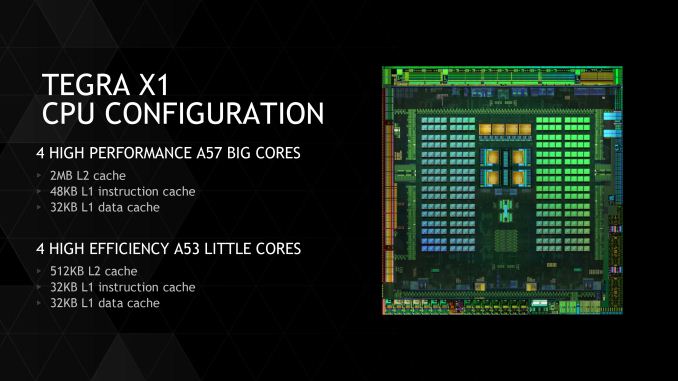
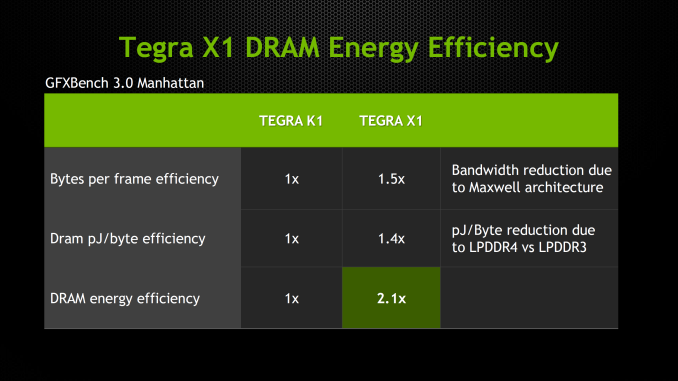
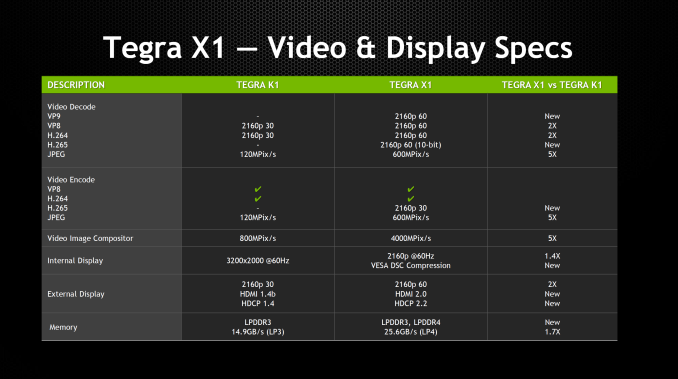








194 Comments
View All Comments
eanazag - Wednesday, January 7, 2015 - link
I'm not totally sure why all the NV and Apple back and forth. I see this as an Apple competitive chip for Android tablets. Why would Apple jump the Imag. Tech ship? At release time they have had the best GPU in a SOC for their iPads. ImgTech has been good for Apple iteration over iteration.May Apple be interested in licensing some IP from NV? Maybe. Apple does a lot of custom work and has a desire to remain in the lead on the mobile SOC front at device release.
lucam - Wednesday, January 7, 2015 - link
Old news, after 2 years nobody knows what happened since then.mpeniak - Thursday, January 8, 2015 - link
Totally!!!jwcalla - Monday, January 5, 2015 - link
It seems like Denver was a huge investment that has produced virtually no fruit so far.Time to market seemed to be NVIDIA's problem with Tegra in the past so it does make sense to get Maxwell out the door ASAP.
syxbit - Monday, January 5, 2015 - link
Exactly. Denver has been a massive disappointment. It really needs to be on 20nm. At 28nm performance is too inconsistent, and throttles too much.I just find it funny how arrogant Nvidia is. They're always boasting and boasting with these announcements, and yet by the time they ship, they're rarely leading (or in the case of the K1, they're leading, but in literally only 1 shipping device).
djboxbaba - Monday, January 5, 2015 - link
Yes! How can they keep going about this on a yearly basis, disappointment after disappointment from NVidia in the mobile sector.Krysto - Monday, January 5, 2015 - link
Denver needs to be at 16nm. And we might still see it, at the end of the year/early next year if Nvidia releases the X1 on 20nm, and then X2 (I really hope they don't release another "X1", like they did this year with K1, making things very confusing) with Denver and on 16nm.name99 - Monday, January 5, 2015 - link
Unlikely that nV will release 16FF this year or early next year. Apple has likely booked all 16FF capacity for the next year or so, just like they did with 20nm. nV (and Qualcomm and everyone else) with get 16FF when Apple has satisfied the world's iPhone 6S and iPad 2015 demands...GC2:CS - Monday, January 5, 2015 - link
Yep.Like on the presentation, boasting about how Tegra K1 is still the best mobile chip (despite A8X matching it at significally lower power (which they don't have a graph for)) despite being released a "year before", while A8X has been released just "now". (While taking nVidia's logic A8X was "released" just few hours after K1 because imagination had annonced Series 6XT GPU's at CES 2014).
Yojimbo - Monday, January 5, 2015 - link
Tegra K1 is a 28nm part and the A8X is a 20nm device. The Shield tablet did launch 3 months before the iPad Air 2. Apple has a huge advantage in time to market. They can leverage the latest manufacturing technologies, and they don't have to demonstrate a product and secure design wins. Even though the shield tablet is an NVIDIA design, I doubt they have such tight control of their suppliers as Apple has, and they can't leverage the same high-volume orders. Apple designs a chip and designs a known product around that chip while the chip is being designed, and they can count on it selling in high volume. So you are making an unfair comparison of what NVIDIA is able to do and of the strength of the underlying architecture. If you want to compare the Series 6XT GPU architecture with K1's GPU architecture I think it should be done on the same manufacturing technology.